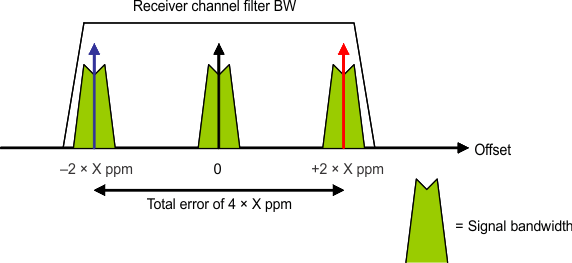SWRA122D January 2007 – September 2018 CC1100 , CC1100E , CC1101 , CC1101-Q1 , CC1110-CC1111 , CC1131-Q1 , CC1151-Q1 , CC430F5123 , CC430F5125 , CC430F5133 , CC430F5135 , CC430F5137 , CC430F5143 , CC430F5145 , CC430F5147 , CC430F6125 , CC430F6126 , CC430F6127 , CC430F6135 , CC430F6137 , CC430F6147
2 Receiver Channel Filter Bandwidth and Crystal Inaccuracies
A phase locked loop (PLL) is used to generate the RF frequency in the CC1100, CC1101, and CC1100E transceivers and the CC1110, CC1111, and CC430 SoCs. The PLL reference frequency is derived from an external crystal. If the crystal frequency is incorrect, the transmitter carrier frequency and the receiver LO frequency will also be incorrect. The crystal frequency error is due to initial tolerance, capacitive loading errors, ageing, and temperature drift.
Example: If the crystal frequency has an error of ±X ppm (parts per million) the RF frequency also has an error of ±X ppm. As an example, if the crystal error is +10 ppm and the CC11xx is programmed for a carrier frequency of 868 MHz, there will be an error in the carrier frequency of 868 MHz×10/1E6 = 8.68 kHz.
The transmitted signal will have a certain signal bandwidth (BWsignal), which depends on the data rate and modulation format. On the receiver side there is a channel filter, which is centered on the down-converted received RF frequency; that is, the intermediate frequency (IF). The channel filter has a programmable bandwidth BWchannel. The signal bandwidth has to be less than the receiver channel filter bandwidth, but we also have to take the frequency error of the transmitter and receiver into account.
If there is an error in the transmitter carrier frequency and the receiver LO frequency, there will also be an error in the IF frequency. For simplicity assume the frequency error in the transmitter and receiver is equal (same type of crystal). If the receiver has an error of –X ppm and the transmitter has an error of +X ppm the IF frequency will have an error of +2 × X ppm (CC11xx uses low side LO injection). Conversely, if the receiver has an error of +X ppm and the transmitter an error of –X ppm the IF frequency will have an error of –2 × X ppm.
Example: If the transmitter crystal error is +10 ppm and the CC11xx is programmed for a carrier frequency of 868 MHz, there will be an error in the carrier frequency of 8.68 kHz. If the receiver crystal error is -10 ppm and the CC11xx is programmed for an LO frequency of 867.7 MHz (300-kHz IF frequency) there will be an error in the LO frequency of –8.677 kHz (approximately the same as the error in the carrier frequency due to the low IF frequency used). The total error in the IF frequency, after down conversion from RF, will be 2 × 8.68 kHz = 17.4 kHz.
 Figure 1. Plot of IF Versus Frequency Error
Figure 1. Plot of IF Versus Frequency Error Figure 1 shows the required minimum channel filter bandwidth BWchannel to account for crystal errors of opposite signs, which is a worst case scenario. BWchannel has to be larger than the maximum signal bandwidth BWsignal plus the maximum frequency error due to crystal inaccuracies.
- XTALppm is the total accuracy of the crystal including initial tolerance, temperature drift, loading, and aging.
- fRF is the RF operating frequency.
where
Example: If both the transmitter and receiver crystal accuracy is ±10 ppm and the CC11xx is programmed for a carrier frequency of 868 MHz with an IF frequency of 300 kHz, BWchannel must be larger than BWsignal + 4 × XTALppm × fRF = BWsignal + 4 × 8.68 kHz.